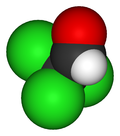Chloral
Chloral, also known as trichloroacetaldehyde or CCl3CHO, is an organic compound with significant historical and industrial relevance. It is a colorless liquid with a pungent odor and was first synthesized in the early 19th century. Chloral is primarily known for its role in the synthesis of chloral hydrate, a sedative and hypnotic drug.
History[edit]
Chloral was first synthesized by the chemist Justus von Liebig in 1832 through the chlorination of ethanol. This discovery marked a significant milestone in organic chemistry, illustrating the transformation of a simple organic molecule into a more complex one through halogenation.
Chemical Properties[edit]
Chloral is a haloaldehyde, characterized by the presence of three chlorine atoms and an aldehyde group attached to the same carbon atom. It is typically a dense, colorless liquid that is soluble in a variety of organic solvents. Chloral tends to hydrolyze in the presence of water to form chloral hydrate, which is more stable and has been widely used in medicine.
Synthesis[edit]
The primary method for synthesizing chloral involves the chlorination of ethanol, which can be conducted using either chlorine gas or a mixture of calcium hypochlorite (bleaching powder) and acetic acid. This reaction produces chloral along with byproducts such as hydrochloric acid and calcium chloride.
Uses[edit]
Chloral's most notable application is in the production of chloral hydrate, which was historically used as a sedative and hypnotic before the development of safer alternatives. Chloral can also undergo further chemical reactions to produce DDT (dichlorodiphenyltrichloroethane), an insecticide that was widely used until concerns about its environmental and health impacts led to widespread bans.
Safety and Environmental Impact[edit]
Chloral is considered a hazardous material due to its potential health effects, which include irritation to the skin, eyes, and respiratory system. It is also a precursor to DDT, which has significant environmental impacts, including bioaccumulation and effects on wildlife. Proper handling and disposal of chloral are essential to minimize these risks.
Conclusion[edit]
While chloral itself is not as widely used today, its derivatives, particularly chloral hydrate, have played a significant role in medicine and chemistry. The compound's reactivity and transformation into various industrially and pharmacologically important compounds continue to make it a subject of study in organic chemistry.
Chloral[edit]
-
Chloral 2D Skeletal
-
Chloral 3D van der Waals
Ad. Transform your life with W8MD's Budget GLP-1 injections from $75


W8MD offers a medical weight loss program to lose weight in Philadelphia. Our physician-supervised medical weight loss provides:
- Weight loss injections in NYC (generic and brand names):
- Zepbound / Mounjaro, Wegovy / Ozempic, Saxenda
- Most insurances accepted or discounted self-pay rates. We will obtain insurance prior authorizations if needed.
- Generic GLP1 weight loss injections from $75 for the starting dose.
- Also offer prescription weight loss medications including Phentermine, Qsymia, Diethylpropion, Contrave etc.
NYC weight loss doctor appointmentsNYC weight loss doctor appointments
Start your NYC weight loss journey today at our NYC medical weight loss and Philadelphia medical weight loss clinics.
- Call 718-946-5500 to lose weight in NYC or for medical weight loss in Philadelphia 215-676-2334.
- Tags:NYC medical weight loss, Philadelphia lose weight Zepbound NYC, Budget GLP1 weight loss injections, Wegovy Philadelphia, Wegovy NYC, Philadelphia medical weight loss, Brookly weight loss and Wegovy NYC
|
WikiMD's Wellness Encyclopedia |
| Let Food Be Thy Medicine Medicine Thy Food - Hippocrates |
Medical Disclaimer: WikiMD is not a substitute for professional medical advice. The information on WikiMD is provided as an information resource only, may be incorrect, outdated or misleading, and is not to be used or relied on for any diagnostic or treatment purposes. Please consult your health care provider before making any healthcare decisions or for guidance about a specific medical condition. WikiMD expressly disclaims responsibility, and shall have no liability, for any damages, loss, injury, or liability whatsoever suffered as a result of your reliance on the information contained in this site. By visiting this site you agree to the foregoing terms and conditions, which may from time to time be changed or supplemented by WikiMD. If you do not agree to the foregoing terms and conditions, you should not enter or use this site. See full disclaimer.
Credits:Most images are courtesy of Wikimedia commons, and templates, categories Wikipedia, licensed under CC BY SA or similar.
Translate this page: - East Asian
中文,
日本,
한국어,
South Asian
हिन्दी,
தமிழ்,
తెలుగు,
Urdu,
ಕನ್ನಡ,
Southeast Asian
Indonesian,
Vietnamese,
Thai,
မြန်မာဘာသာ,
বাংলা
European
español,
Deutsch,
français,
Greek,
português do Brasil,
polski,
română,
русский,
Nederlands,
norsk,
svenska,
suomi,
Italian
Middle Eastern & African
عربى,
Turkish,
Persian,
Hebrew,
Afrikaans,
isiZulu,
Kiswahili,
Other
Bulgarian,
Hungarian,
Czech,
Swedish,
മലയാളം,
मराठी,
ਪੰਜਾਬੀ,
ગુજરાતી,
Portuguese,
Ukrainian


